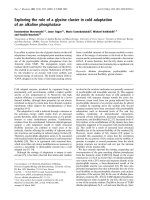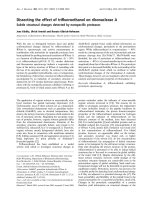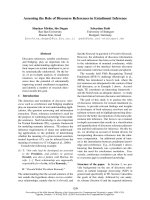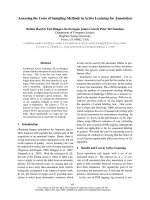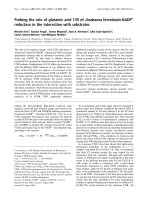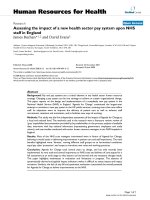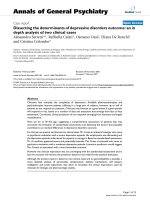Báo cáo y học: " Assessing the efficacy of a modified assertive community-based treatment programme in a developing country" potx
Bạn đang xem bản rút gọn của tài liệu. Xem và tải ngay bản đầy đủ của tài liệu tại đây (267.44 KB, 8 trang )
RESEARC H ARTIC LE Open Access
Assessing the efficacy of a modified assertive
community-based treatment programme in a
developing country
Ulla A Botha
1*
, Liezl Koen
1
, John A Joska
2
, Linda M Hering
3
, Piet P Oosthuizen
1
Abstract
Background: A number of recently published randomized controlled trials conducted in developed countries have
reported no advantage for assertive interventions over standard care models. One possible explanation could be
that so-called “standard care” has become more comprehensive in recent years, incorporating some of the salient
aspects of assertive models in its modus operandi. Our study represents the first randomise d controlled trial
assessing the effect of a modified assertive treatment service on readmission rates and other measures of outcome
in a developing country.
Methods: High frequency service users were randomized into an intervention (n = 34) and a control (n = 26)
group. The control group received standard community care and the active group an assertive intervention based
on a modified version of the international model of assertive comm unity treatment. Study visits were conducted at
baseline and 12 months with demographic and illness information collected at visit 1 and readmission rates
documented at study end. Symptomatology and functioning were measured at both visits using the PANSS, CDSS,
ESRS, WHO-QOL and SOFAS.
Results: At 12 month follow-up subjects receiving the assertive intervention had significantly lower total PANSS
(p = 0.02) as well as positive (p < 0.01) and general psycho pathology (p = 0.01) subscales’ scores . The mean SOFAS
score was also significantly higher (p = 0.02) and the mean number of psychiat ric admissions significantly lower
(p < 0.01) in the intervention group.
Conclusions: Our results indicate that assertive interventions in a developing setting where standard community
mental services are often under resourced can produce significant outcomes. Furthermore, these interventions
need not be as expensive and comprehensive as international, first-world models in order to reduce inpatient days,
improve psychopathology and overall levels of functioning in patients with severe mental illness.
Background
In recent years there has been a worldwide focus on
assertive community interventions in an attempt to
address some of the repercussions of the implementa-
tion of deinstitutionalization [1-6]. Although these inter-
ventions have often been implemented under different
names such as assertive outreach, intensive case man-
agement and assertive community treatment, essentially
they have had the same core characteristics [4,7] (See
Additional file 1).
A Cochrane review published in 1998 concluded that
assertive interventions exhibited several advantages above
standard care, such as improved engagement with
services, reduction in readmissions and days spent in
hospital (DIH), benefits in employment and accommoda-
tion status, as well as improved patient satisfaction [3].
The review found no differences in severity of psycho-
pathology or level of functioning, but reported a reduc-
tion in inpatient costs, even though n o benefits were
shown when other costs were taken in account.
With the exception of Lambert et al, recent publica-
tions have failed to replicate the previously reported effi-
cacy of assertive interventions over standard care
models, with a number of randomized controlled trials
* Correspondence:
1
Department of Psychiatry, University of Stellenbosch, Tygerberg, South
Africa
Full list of author information is available at the end of the article
Botha et al. BMC Psychiatry 2010, 10:73
/>© 2010 Botha et al; licensee BioMed Central Ltd. This is an Open Access article distributed under the terms of the Creative Commons
Attribution License ( which pe rmits unrestricted use, distribution, and reproduction in
any medium, provided the original work is properly cited.
showing no advantage for Assertive Community Treat-
ment (ACT) in reducing inpatient care and other clini-
cal outcomes [2,4-6,8,9]. Improved engagement with
services and increased patient satisfaction has been the
only consistently positive findings. One of the explana-
tions offered is the likelihood that so-called “standard
care” has become more comprehensive in recent years,
incorporating some of the salient aspects of assertive
models in its modus operandi [2,5,10]. Some studies
were criticized for not defining control groups well
enough, since “treatment as usual” may differ between
settings and should therefore be properly defined as a
separate intervention [10]. Another possible explanation
is the fact that hospital readmissions h ave been the
most frequently measured and often primary outcome.
This variable may be particularly difficult to reduce in a
system where recidivists only have access to beds when
they are extremely ill and are again discharged before
they are completely stable [2,5].
Psychiatric services in some developing countries have
had similar experiences to those of developed countries
with regards to demand for in-pat ient services and reci-
divism [1,11-13]. The impact of deinstitutionalization
became evident only in retrospect, and has placed a sig-
nificant burden on already overburdened community
services [12,14]. Community psychiatric services in
South Africa are based in primary health care institu-
tions and have to contend with a lack of resources, par-
ticularly services offering residential specialized care.
In many cases these services still rely heavily on
resources that are only accessible through hospital-
based care. High rates of unemployment, poor social cir-
cumstances, substan ce abuse and high levels of v iolen ce
and crime, further contribute to the unique challenge
mental health services face in developing countries.
In a previous paper from our group, we found the
characteristics of high frequency users (HFUs) in the
South African setting to be quite similar in profile to
those described in the international literature [15]. The
pauc ity of resources was sho wn to be amongst the driv-
ing forces behind high frequency use, along with poor
medication adherence and substance abuse. Stein et al
suggested that South African clinicians should develop
their own model of providing community care through
strengthening of existing community structures and
stressed that intensive care with small caseloads, may
not be realistic in the South African setting [16].
It is against this backdrop that the state psychiatric
management team in the Western Cape Province, South
Africa, introduced an assertive community treatment
program for each of the three regional psychiatric hospi-
tals in an attempt to reduce demand for inpatient beds
and to alleviate some of the pressure on community
psychiatric services [1]. Since the model of care provided
by such teams in high income countries would not be
realistic or cost-effective in the South African setting,
the international model was modified to allow for larger
caseloads and consequently less frequent contacts. Se e
table 1 for comparisons between ACT teams and stan-
dard community mental health teams.
Aim
The purpose of this study was to determine the impact
of a tailored, assertive treatment service on readmission
rates and other measures of outco me in HFUs of
psychiatric services in a developing country.
Methods
This study was conducted at Stikland Hospital, one of
the three large state psychiatric hospitals in Cape Town,
South Africa. The hospital, along with two others, pro-
vides inpatient services to the whole of the Western
Cape Province, servicing a population of approximately
5 m illion people. The combined in-patient numbers for
patients with severe mental illness in the three hospitals
is approximately 450. The Stikland Hospital ACT Team
consisted of a fu ll-time psychiatrist, a social worker and
a chief professional nurse.
All clients who presented for admission to Stikland
Hospital over a pre -defined period in 2007/08 and who
had a pr eviously established, documented diagnosis of
schizophrenia or schizo-affective disorder (DSM-IV-TR),
were considered for inclusion [17]. In order to be
included, participants had to give written, informed con-
sent. The study was approved by the research ethics
comm ittees of both the Universities of Stellenbo sch and
Cape Town. The research study was conducted parallel
to a service component into which patients not meeting
research criteria, but with a similar pattern of high fre-
quency use, were recruited. Research numbers therefore
do not reflect overall caselo ads; patien ts participating in
the research constituted only one third of the overall
caseload. Originally, the resea rch project was intended
as a multi-site project, covering the three c atchment
areas in the metro, but due to high turnover in staff, the
study could not be completed at t he other two institu-
tions. This reduced the number of participants who
were included in the study, but had the advantage that a
single investigator (UB) performed all the assessments.
To be included as HFUs participants had to fulfill the
full criteria as described in Additional file 2: Table S1.
We utilized a modified version of Weiden’s HFU-criteria
adapted to local circumstances [18] ( Additional file 2:
Table S1). Participants were excluded if they had (1)
a severe, unstable, co-morbid, medical illness (2) were
unable to give written informed consent or (3) if
Botha et al. BMC Psychiatry 2010, 10:73
/>Page 2 of 8
another co-morbid Axis I or II diagnosis, other than
schizophrenia or schizo-affective disorder, was the
current focus of treatment.
After inclusio n, 60 participants identified as HFUs who
provided informed, written consent, were randomized
using standardized tables to either the intervention group
or the treatment as usual group (see Figure 1).
Participants from both groups were assessed at inclu-
sion, prior to discharge and at 12 months after inclu-
sion.Allassessmentsweredonebyasingle
investigator, and all data was entered into an electronic
Case Report Form (eCRF). At each of these visits, the
following information wa s gathered and rating scales
administered:
○ Positive and Negative Symptom Scale (PANSS)
[19]
○ Extrapyramidal symptom rating scale (ESRS) [20]
○ Calgary Depression Scale for Schizophrenia
(CDSS) [21]
○ Social and Occupational Functioning Assessment
Scale (SOFAS) [22]
○ World H ealth Organization Quality of Life ques-
tionnaire (WHO-QOL) [23]
○ Information about diagnosis, illness and medica-
tion (obtained from medical folder)
○ Confirmation of demographics and living
arrangements
Participants from the treatment as usual group were
discharged into the existing community mental health
service and were only contacted again af ter 12 months
for the final assessment. Participants from the interven-
tion group were each assigned a key worker in the form
of a senior social worker or a chief professional nurse.
Key workers started engaging subjects and carers prior
to discharge, with the primary focus on building a thera-
peutic relationship.
The nature of the intervention was tailored as closely
as possible to the international model of assertive com-
munity treatment, with the two main exceptions being
the size o f caseloads and frequency of visits. It was
agreed at the outset that caseloads carried by interna-
tional teams would not be realistic in the context of an
under-resourced, developing country. ( See table 1 for
characteristics of team.) A conse nsus caseload number
of 80 patients per team was reached, with individual
caseloads not exceeding 35. Fidelity to the international
model was assessed with the Dartmouth Assertive Com-
munity Treatment Scale (DACTS) with a total score of
3.1, indicating moderate fidelity [24]. The DACTS was
developed by Teague et al as an independent scale used
to assess adherence to evidence-based practices particu-
lar to assertive community treatment. The scale contains
28 program-specific items, wherein each item on the
scale is rated on a 5-point scale ranging from 1 to 5 indi-
cating the degree to which principles were implemented.
The scale is accompanied by a guideline for scoring of
each item. Higher scores (4-5) are indicative of high
fidelity, with scores between 3 and 4 indicating moder-
ate fidelity and those below 3, low fidelity [24].
Key workers acte d as main care coordinators, but
caseloads were often shared between m embers of the
team. A major focus of the team was on engagement
and maintenance of adherence to treatment. Since
resources were limited, the team focused on strengthen-
ing access to existing resources in the community and
building new ties with organizations that may offer addi-
tional services. Patients were frequently referred to
occupational therapy and psychology services, although
no full time staffing was available from these disciplines.
Since there are no inpatient dual diagnosis rehabilitation
Table 1 Work style of ACT team compared to standard care
ACT team Community Mental Health team
Overall patient load 80-100 patients ± 600 patients excluding assessments of new patients
Individual caseload Maximum 35 250
Workstyle Key workers act as care coordinator bur caseloads are
shared
Individual caseloads
Site of most visits >50% contacts are home visits Office based
Engagement Assertive; focus on engagement Non-assertive, no follow-up of missed appointments/
reports of non-compliance
Working hours Office hours Office hours
24 hour cover Patients referred to hospital-based after-hours service
coordinated by ACT
After-hours service of catchment area
Frequency of contacts Individualized according to patient need; fortnightly Depends on caseloads, varies between monthly to
three monthly
Disciplines available Full-time psychiatrist, social worker, psychiatric nurse, access
to psychologist, occupational therapist, dual diagnosis
outpatient service
Full-time psychiatric nurse, access to social worker and
psychiatrist, varied access to occupational therapist and
psychologist
Botha et al. BMC Psychiatry 2010, 10:73
/>Page 3 of 8
facilities in the area, patients were referred to main-
stream programs when this service was required. The
majority of contacts (>50%) were in the community,
mainly in the form of home visits. The team was based
at Stikland Hospital. This held both advantages and dis-
advantages. On t he one hand, the team w as able to
draw from the various resources in the hospital setting
to strengthen the service it provided, such as access to
day centres, occupational therapy assessments and coor-
dination of medication issuing. One major disadvantage
of the teams’ location was the histori cal, custodial repu-
tation of state institutions. The t eam therefore had to
work harder to challenge misconceptions about its
purpose.
At 12 month follow-up, information was collected
about readmissions and changes in medication. Remis-
sion rates were based on Andreasens’ criteria [25].
Patients in the intervention group remained in the ser-
vice and those in the c ontrol group were, at study end,
given the option to be included in the service as well.
There was no official drop-out policy and none of the
intervention patients dropped out during the course of
the study.
Statistical Analysis
All d ata were entered into a single, electronic database.
Statistical Analysis was done with Statistica version 9
software (Statsoft, Inc 2009). As some of the data was
descriptive in nature, results are provided as means with
standard deviations, where appropriate. Categorical vari-
ables were compared using chi-square or Fisher’sexact
test, where applicable. Differences in groups in terms of
continuous variables were analyzed using Student’ s
T-test. All statistical tests were two-sided and a signifi-
cance level of 0.05 was used throughout.
Results
A total of 34 participants were included in the intervention
arm. Five of these did not complete the study: three were
never discharged during the study period and one died
before study completion. The other was re-admitted
within two weeks after discharge and then transferred to a
long stay ward where he remained until study completion.
Patients
randomised
(n=60)
Assertive Intervention
(n=34)
All signed informed consent
Control Group
(standard care)
(n=26)
All signed informed consent
• PANSS
• ESRS
• CDSS
• CGI
• WHO-QOL
• SAQ
• Illness information
• Medication
Did not complete study
(n=5)
• Died (n=1)
• Long term ward
(n=4)
Did not complete study
(n=5)
• Received>standard
care (n=1)
• Long term ward (n=2)
• Could not be found at
12 month follow-up.
(n=2)
Interviewed at
12 months
(n=29)
Interviewed at
12 months
(n=21)
• PANSS
• ESRS
• CDSS
• CGI
• WHO-QOL
• Readmissions
• Medication
Figure 1 Study methodology. 60 participants identified as HFUs who provided informed consent, were randomized using standardized tables.
34 participants were randomised to the intervention group and 26 to the treatment as usual group. Participants from both groups were
assessed at inclusion and rating scales as described in the methods section were performed at each of these visits. Participants from both
groups were assessed again after 12 months for the final assessment. On this visit data was collected and rating scales were performed again. In
each group, 5 participants did not complete the study.
Botha et al. BMC Psychiatry 2010, 10:73
/>Page 4 of 8
No data was therefore included for the first three but for
the last two data from study visit 1 as well as the period
they remained on the study was included. Of the 26 parti-
cipants who initially consented to act as controls, 21 com-
pleted the study. Two could not be traced after
12 months, one had been seen monthly by a psychiatrist
through-out the year and was therefore considered not to
have received standard care. The other two w ere trans-
ferred to long-stay wards shortly after inclusion. Almost
twothirdsofpatientsinbothgroupsweremaleand
approximately the same number was unmarried. With one
exception from both groups, all patients were unemployed
and lived in their family home. Twenty-three intervention
and nineteen control participants received disability
grants. See Table 2 for detailed demographics.
Baseline scores in psychopathology wer e similar
between the groups, except for a significantly higher
mean score on the PANSS Negative Scale for the inter-
vention group (p = 0.01). At 12 month follow-up, the
intervention group had significantly lower scores in the
subscales for PANSS positive (p < 0.01) and general
psychopathology symptom scales (p = 0.01), as well as
for PANSS total scores (p = 0.02). Also, the difference
in PANSS Negative Scores was no longer significant.
The mean SOFAS score was significantly higher in the
intervention group (p = 0.02). No significant differences
were found in scores for CD SS and WHO-QOL. There
was no significant difference in the use of depot medica-
tion, nor was there any significant difference in ESRS
scores. Although there was a large numerical difference
in the number of participants who reached remission
between the two gr oups, this number did not reach sig-
nificance. The risk for readmission was significantly
higher in the control group with 10 patients (n = 31) in
the intervention group being readmitted during the
course of the year and 15 in the control group (n = 21).
The mean number of admissions per capita for the
intervention group was 0.41 and 1.19 in the control
group (p < 0.01). The mean number of inpatient days
was also significantly higher in the control group, both
for psychiatric (p = 0.02) and non-psychiatric admissions
(p = 0.04). (see Tables 3 & 4 for full results).
Discussion
We report on the first detailed prospective study of
assertive community treatment in South Africa. Our
results suggest that assertive community treatment may
not only reduce readmission rates in a setting with lim-
ited resources, but may also impact on the severity of
psychopathology and level of functioning [2,4-6,8].
Table 2 Demographic differences between Intervention group and Control Group
Intervention Control
Mean (±SD) n % Mean (±SD) n % x
2
t-value df p
Age 30.55 (±9.09) 31 34.81 (±11.02) 21 -1.52 50 0.13
Gender male 23 74.19 15 71.43 0.05 1 0.83
female 8 25.80 6 28.57
mixed* 29 93.55 19 90.48
Ethnicity black* 1 3.23 2 9.52 1.55 2 0.46
caucasian 1 3.23 0 0
Residential area metro** 31 100 19 90.48 0.19
rural 0 0 2 9.52
Education level elementary 16 51.61 7 33.33
secondary 12 38.71 10 47.62 2.89 3 0.41
≥Gr12 3 9.68 3 14.29
none 0 0 1 47.62
Marital status single 25 80.65 16 76.19
married 4 12.90 2 9.52 0.95 2 0.62
divorced 2 6.45 3 14.29
Employment Status unemployed 30 96.77 21 100 0.69 1 0.41
casual*** 1 3.23 0 0
Disability grant yes 23 74.19 19 90.48 2.14 1 0.14
no 8 25.80 2 9.52
*Mixed refers to participant with mixed African-Caucasian ancestry. Black refers to black African participants.
**Participants who live within the city limits of the City of Cape Town.
***Participants who are employed on a part-time basis. Note that no participant s were fully employed.
Botha et al. BMC Psychiatry 2010, 10:73
/>Page 5 of 8
These findings appear to stand in contrast to those
reported on by others in high income countries. Even
though our team did not h ave a high fidelity as demon-
strated by the DACT score, the service offered appeared
to be significantly more effective than standard care in
reducing readmissions and improving clinical outcomes.
The impact of assertive community treatment is likely
to reside in the additional resources provided by the
intervention in a poorly reso urced setting. Existing com-
munity services are over-burdened with a rapidly grow-
ing population of mental health care users. Community
mental health service are hampered by staffing
shortages, limited access to residential care, restricted
availability of vocational rehabilitation and related ser-
vice. The high demand for services is fuelled by high
rates of substance abuse, the HIV epidemic, and poor
social conditions. The literature on ACT i ndicates that
assertiveinterventionsmaybemoreeffectivewhere
comm unity services are less comprehensive [10,26]. Iro-
nically, it is in these exact settings, often in developing
countries, where assertive interventions may not be
affordable or feasible.
Table 3 Differences in clinical outcomes between Intervention group and Control Group (1)
Item Intervention Control
Mean (±SD) n Mean (±SD) n t-value df p
Baseline (mean) PANNS-P total 32.29 (±5.62) 31 31.43 (±5.21) 21 0.56 50 0.58
PANNS-N total 25.06 (±6.82) 31 20.00 (±6.80) 21 2.63 50 0.01*
PANNS-G total 48.16 (±9.21) 31 45.67 (±6.37) 21 1.08 50 0.29
Intervention (n = 31)
Control (n = 21)
PANNS-Total 105.52 (±18.58) 31 97.10 (±15.20) 21 1.72 50 0.09
SOFAS 34.29 (±3.58) 31 36.29 (±6.37) 21 -0.89 50 0.38
CDSS 2.35 (±18.58) 31 1.05 (±1.47) 21 1.58 50 0.12
ESRS-questionnaire 3.16 (±2.48) 31 2.43 (±2.40) 21 1.06 50 0.29
ESRS-parkinsonism 8.84 (±7.28) 31 8.81 (±5.55) 21 0.02 50 0.99
ESRS-dystonia 0.00 (±0.00) 31 0.10 (±0.44) 21 -1.22 50 0.23
ESRS-dyskinetic 0.61 (±2.38) 31 0.57 (±2.62) 21 0.06 50 0.95
Endpoint PANNS-P total 12.52 (±6.0) 29 19.38 (±8.8) 21 -3.28 48 0.00*
PANNS-N total 16.55 (±6.1) 29 19.33 (±4.6) 21 -1.76 48 0.09
PANNS-G total 28.45 (±8.2) 29 34.81 (±9.1) 21 -2.58 48 0.01*
PANNS-Total 57.52 (±17.4) 29 73.52 (±19.2) 21 -3.07 48 0.00*
Intervention (n = 29)
Control (n = 21)
SOFAS 61.97 (±9.1) 29 54.90 (±10.8) 21 2.50 48 0.02*
CDSS total 0.69 (±1.4) 29 0.81 (±3.3) 21 48 0.86
ESRS-questionnaire 1.90 (±1.23) 29 1.90 (±1.51) 21 -0.02 48 0.98
ESRS-parkinsonism 9.03 (±8.20) 29 0.48 (±8.07) 21 0.48 48 0.63
ESRS-dystonia 0.00 (±0.00) 29 0.00 (±0.00) 21 48
ESRS-dyskinetic 0.55 (±1.24) 29 0.57 (±1.57) 21 -0.05 48 0.96
*Significance at p < 0.05.
Table 4 Differences in clinical outcomes between Intervention group and Control Group (2)
Item Intervention Control
Mean (±SD) n % Mean (±SD) n % x
2
t-value df p-value
Remission yes 13 44.83 6 28.57 1.367 1 0.24
no 16 55.17 15 71.43 7
Readmission yes 10 34.48 15 71.43 6.65 1 0.01*
no 19 65.52 6 28.57
number readmissions 0.41 (±0.63) 29 1.19 (±0.98) 21 3,41 48 0.00*
days in hospital (DIH) 24.69 (±47.43) 29 67.19 (±76.31) 21 -2.43 48 0.02*
non-psychiatric DIH 0.07 (±0.37) 29 2.33 (±5.65) 21 2.16 48 0.04*
*Significance at p < 0.05.
Botha et al. BMC Psychiatry 2010, 10:73
/>Page 6 of 8
Additional reasons for the positive outcome in this
study include factors related to the estab lishment of a
novel service. Sytema et al commented on the influ ence
a newly established team may have on outcomes of a
trial [5]. On the one hand, enthusiasm and motivation
may be higher in a newly established team that has
something to prove. On the other hand, there is the
pressure of developing a new service that has never
been tried before, especially in this case where the
model of care has been adapted.
The positive effect of assertive community treatment
in our setting is unlikely to be related to medication use
and dose, since no significant differences were found
between the two groups in this respect. Comparisons
drawn between low frequency users (LFUs) and HFUs
in the same population in the past, have shown a higher
incidence in the use of depot medication in LFUs,
which may improve overall compliance and prolong per-
iods between admissions [15]. However, there was no
difference in the use of depot medication between the
two groups in this study at endpoint.
In addition to reduced admission rates, we also noted
that participants in the intervention spent less time in
hospital (referred to as days in hospital- DIH). Since the
patients in the intervention group had more frequent
service contacts, it is likely t hat intervention occurred
earlier in the course of relapse and that patients from
this group were therefore less severely ill on readmission
than the patients in the control group. Also, patients in
the intervention group had streamlined access to emer-
gency and inpatient services, because of the involvement
of the ACT team. The higher number of non-psychiatric
inpatient days in the control group is probably a result
of the pathways followed to admission. Due to the fact
that there are limited bed vacancies at state institutions
on the day admission is required, patients are often
admitted to medical beds in secondary hospitals and put
on a waiting list until beds become available at a psy-
chiatric hospital. Patients in the ACT service did not
follow this route, as one of the advantages of the service
is the streamlined access to beds when in crisis.
One may speculate that t hese outcomes reflect more
on the level of standard care in South Africa rather than
theefficacyoftheinterventionoffered.Also,somemay
question whether such a comparatively expensive inter-
vention is an appropriate way to util ize the limited
resources in developing countries. It is therefore reas-
suring and important to note that even with the modi-
fied caseloads and reduced frequency in contacts,
significant outcomes can be produced on more than one
level. This could be an indication that there may be a
place for assertive community treatment strategies in
developing countries, althou gh these should be tailored
to the needs and resources of the particular population
and country. Therefore, with the clinical benefits of this
particular intervention already demo nstrated in our set-
ting, we believe the next logical step should be an
urgent cost-benefit analysis in order to present policy
makers with the data needed to support funding for a
wider roll-out of this program.
Conclusion
This is the first study of its kind conducted in a develop-
ing country. The results indicate that assertive interven-
tions in this setting need not consume resources to the
degree that high income country models use to produce
positive outcomes. Modified assertive interventions that
focus on m aintaining adherence and offering additional
support may not only reduce inpatient days but also
improve psychopathology in patients with severe mental
illness. Standard community mental health services in
developing countries often lack necessary resources and
funding to pro vide comprehensive care to the severely ill,
HFU patient. Ways should be explored in which tradi-
tional assertive models of care can be adapted within the
financial constraints of limited budgets, while still retain-
ing the core features necessary to bring about change.
Limitations
This was an unblinded study, with all the inherent risks
involved when this kind of methodology is used. Due to
high staff turnover at other sites, numbers of subjects
recruited were lower than expected, and from a single
site only which could limit generalizability. The ethnic
distribution in this sample is not representative of the
entire population of the country, since the study was
conducted in an area where the predominant ethnic
representation is that of mixed race. Ideally, outcomes
should be measured for longer than 12 months since
some clinical outcomes may change over time.
Additional material
Additional file 1: Key Elements of ACT. Contains description of core
elements defining Assertive Community Treatment as defined by Burns
et al. This model were adapteded from the original PACT model
described by Stein and Test in 1992.
Additional file 2: Table S1. Modified Weiden’s criteria for differentiating
high frequency (HFU) and low frequency (LFU) schizophrenia-spectrum
disorder users of psychiatric services.
Declaration of competing interests
The authors declare that they have no competing interests.
Authors’ contributions
All authors conceived of and designed the study. UB acquired the data. PO
performed the statistical analysis. UB prepared the first draft of the
manuscript and PO and LK made significant contributions to the final draft.
All authors read and approved the final manuscript.
Botha et al. BMC Psychiatry 2010, 10:73
/>Page 7 of 8
Author details
1
Department of Psychiatry, University of Stellenbosch, Tygerberg, South
Africa.
2
Department of Psychiatry, University of Cape Town, Cape Town,
South Africa.
3
Associated Psychiatric Hospitals, Cape Town, South Africa.
Received: 19 April 2010 Accepted: 15 September 2010
Published: 15 September 2010
References
1. Botha U, Koen L, Oosthuizen P, Joska J, Hering L: Assertive community
treatment in the South African context. Afr J Psychiatry (Johannesbg) 2008,
11:272-275.
2. Killaspy H, Kingett S, Bebbington P, Blizard R, Johnson S, Nolan F, Pilling S,
King M: Randomised evaluation of assertive community treatment: 3-
year outcomes. Br J Psychiatry 2009, 195:81-82.
3. Marshall M, Lockwood A: Assertive community treatment for people with
severe mental disorders. Cochrane Database Syst Rev 2000, CD001089.
4. Smith L, Newton R: Systematic review of case management. Aust N Z J
Psychiatry 2007, 41:2-9.
5. Sytema S, Wunderink L, Bloemers W, Roorda L, Wiersma D: Assertive
community treatment in the Netherlands: a randomized controlled trial.
Acta Psychiatr Scand 2007, 116:105-112.
6. Essock SM, Mueser KT, Drake RE, Covell NH, McHugo GJ, Frisman LK,
Kontos NJ, Jackson CT, Townsend F, Swain K: Comparison of ACT and
standard case management for delivering integrated treatment for co-
occurring disorders. Psychiatr Serv 2006, 57:185-196.
7. Burns T, Firn M: Assertive Outreach in Mental Health; a manual for
practitioners. Oxford university press 2002. Oxford University Press 2002.
8. Hangan C: Introduction of an intensive case management style of
delivery for a new mental health service. Int J Ment Health Nurs 2006,
15:157-162.
9. Lambert M, Bock T, Schottle D, Golks D, Meister K, Rietschel L,
Bussopulos A, Frieling M, Schodlbauer M, Burlon M, Huber CG, Ohm G,
Pakrasi M, Chirazi-Stark MS, Naber D, Schimmelmann BG: Assertive
community treatment as part of integrated care versus standard care: a
12-month trial in patients with first- and multiple-episode schizophrenia
spectrum disorders treated with quetiapine immediate release (ACCESS
Trial). J Clin Psychiatry 2010.
10. Burns T: End of the road for treatment-as-usual studies? Br J Psychiatry
2009, 195:5-6.
11. Gastal FL, Andreoli SB, Quintana MI, Almeida GM, Leite SO, McGrath J:
Predicting the revolving door phenomenon among patients with
schizophrenic, affective disorders and non-organic psychoses. Rev Saude
Publica 2000, 34:280-285.
12. Lazarus R: Managing de-institutionalization in a context of change: The
case of Gauteng, South Africa. S Afr Psychiatry Rev 2005;8:65-69. South
African Psychiatry Review 2005, 8:65-69.
13. Patel V, Araya R, Chatterjee S, Chisholm D, Cohen A, De Silva M, Hosman C,
McGuire H, Rojas G, van Ommeren M: Treatment and prevention of
mental disorders in low-income and middle-income countries. Lancet
2007, 370:991-1005.
14. Singh BS, Castle DJ: Why are community psychiatry services in Australia
doing it so hard? Med J Aust 2007, 187:410-412.
15. Botha UA, Koen L, Joska JA, Parker JS, Horn N, Hering LM, Oosthuizen PP:
The revolving door phenomenon in psychiatry: comparing low-
frequency and high-frequency users of psychiatric inpatient services in a
developing country. Soc Psychiatry Psychiatr Epidemiol
2010, 45:461-468.
16. Stein DJ, Allwood C, Emsley RA: Community care of psychiatric disorders
in South Africa–lessons from research on deinstitutionalization. S Afr Med
J 1999, 89:942-943.
17. American Psychiatric Association: The diagnostic and statistical Manual of
Mental Disorders, Fourth edition, Text revision, (DSM-IV-TR). American
Psychiatric Press, Washington DC 2000.
18. Weiden P, Glazer W: Assessment and treatment selection for “revolving
door” inpatients with schizophrenia. Psychiatr Q 1997, 68:377-392.
19. Kay SR, Fiszbein A, Opler LA: The positive and negative syndrome scale
(PANSS) for schizophrenia. Schizophr Bull 1987, 13:261-276.
20. Chouinard G, Margolese HC: Manual for the Extrapyramidal Symptom
Rating Scale (ESRS). Schizophr Res 2005, 76:247-265.
21. Addington D, Addington J, Maticka-Tyndale E: Assessing depression in
schizophrenia: the Calgary Depression Scale. Br J Psychiatry Suppl 1993,
39-44.
22. Morosini PL, Magliano L, Brambilla L, Ugolini S, Pioli R: Development,
reliability and acceptability of a new version of the DSM-IV Social and
Occupational Functioning Assessment Scale (SOFAS) to assess routine
social functioning. Acta Psychiatr Scand 2000, 101:323-329.
23. Kusel Y, Laugharne R, Perrington S, McKendrick J, Stephenson D, Stockton-
Henderson J, Barley M, McCaul R, Burns T: Measurement of quality of life
in schizophrenia: a comparison of two scales. Soc Psychiatry Psychiatr
Epidemiol 2007, 42:819-823.
24. Teague GB, Bond GR, Drake RE: Program fidelity in assertive community
treatment: development and use of a measure. Am J Orthopsychiatry
1998, 68:216-232.
25. Andreasen NC, Carpenter WT Jr, Kane JM, Lasser RA, Marder SR,
Weinberger DR: Remission in schizophrenia: proposed criteria and
rationale for consensus. Am J Psychiatry 2005, 162:441-449.
26. Tyrer P: The future of specialist community teams in the care of those
with severe mental illness. Epidemiol Psichiatr Soc 2007, 16:225-230.
Pre-publication history
The pre-publication history for this paper can be accessed here:
/>doi:10.1186/1471-244X-10-73
Cite this article as: Botha et al.: Assessing the efficacy of a modi fied
assertive community-based treatment programme in a developing
country. BMC Psychiatry 2010 10:73.
Submit your next manuscript to BioMed Central
and take full advantage of:
• Convenient online submission
• Thorough peer review
• No space constraints or color figure charges
• Immediate publication on acceptance
• Inclusion in PubMed, CAS, Scopus and Google Scholar
• Research which is freely available for redistribution
Submit your manuscript at
www.biomedcentral.com/submit
Botha et al. BMC Psychiatry 2010, 10:73
/>Page 8 of 8
